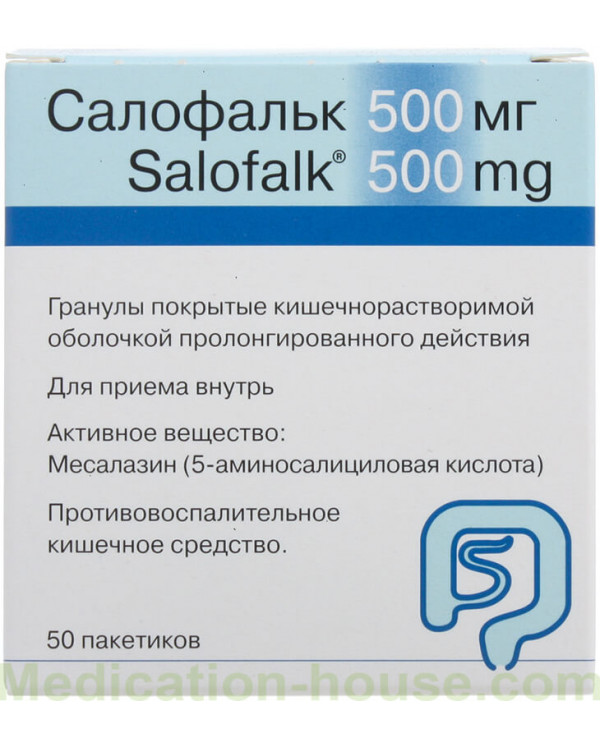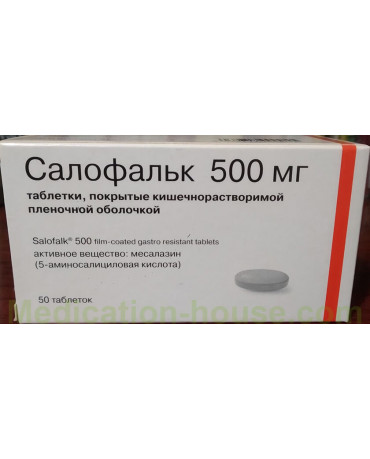Salofalk granules instruction
You can buy Salofalk granules on this page
Structure
In 1 dose (sachet) of enteric-coated granules contains: Mesalazine (5-aminosalicylic acid) 500 mg
Composition of the core: microcrystalline cellulose 400.0 mg, hypromellose 36.0 mg, anhydrous colloidal silicon dioxide 0.5 mg, eudrajit NE 40 D (40% dispersion of methyl methacrylate and ethyl acrylate copolymer (2: 1) and 2% nonoxynol) in terms of dry matter 90.0 mg, magnesium stearate 15.5 mg, dry matter 33% simethicone emulsion (consists of 92% simethicone 7.7%, methyl cellulose, 0.3% sorbic acid) 1.0 mg
The composition of the inner shell: Hypromellose 4.0 mg, methacrylic acid and methyl methacrylate, copolymer (1: 1) (Eudrajit L 100) 150.0 mg, triethyl citrate 15.0 mg, talc 40.0 mg, magnesium stearate 10.0 mg, titanium dioxide 25.0 mg
The composition of the outer shell: Carmellose sodium 30.0 mg, titanium dioxide 10.0 mg, aspartame 2.0 mg, anhydrous citric acid 6.0 mg, vanilla flavor 4.0 mg, talc 11.0 mg, povidone K-25 10 0 mg
Packaging: 500 mg enteric-coated granules in 1 sachet. In packing of 50 bags.
Pharmachologic effect
Salofalk granules has a local anti-inflammatory effect due to the inhibition of neutrophilic lipoxygenase and the synthesis of prostaglandins and leukotrienes.
Slows down migration, degranulation, phagocytosis of neutrophils, as well as the secretion of immunoglobulins by lymphocytes.
It has an antioxidant effect (due to the ability to bind to free oxygen radicals and destroy them). Mesalazine can also trap radicals formed from reactive oxygen compounds. Results from in vitro studies indicate a possible role for lipoxygenase inhibition.
The effect on the content of prostaglandins in the intestinal mucosa was also shown.
With oral administration, mesalazine has a predominantly local effect in the intestinal mucosa and submucosal layer, acting from the side of the intestinal lumen. Therefore, it is important that mesalazine is available in the area.
The ratio of systemic bioavailability and plasma concentration of mesalazine is not significant in terms of therapeutic efficacy, but rather serves as a factor affecting safety.
Ensuring the release of the active substance in the right place helps that Salofalk granules are resistant to gastric juice and are pH-dependent (due to the coating in the form of Eudrajit L) and delayed (due to the matrix structure of the granules) release of mesalazine.
Indications
Exacerbation of ulcerative colitis of moderate and mild severity.
- Maintenance of remission and / or prolonged therapy of ulcerative colitis.
Contraindications
Hypersensitivity to the components of the drug and other derivatives of salicylic acid.
- Blood diseases.
- Peptic ulcer of the stomach and duodenum.
- Deficiency of glucose-6-phosphate dehydrogenase.
- Hemorrhagic diathesis.
- Severe renal / liver failure.
- Children's age (up to 6 years).
- Phenylketonuria.
Carefully
Pregnancy (I trimester).
- Renal / liver failure of mild to moderate severity.
- Diseases of the lungs (especially bronchial asthma).
Pregnancy and lactation
Salofalk granules should be used during pregnancy only in cases where the potential benefits of its use to the mother outweigh the possible risk to the fetus.
Salofalk granules can be used in women during breastfeeding only if the potential effect of its use on the mother outweighs the possible risk of adverse effects on the baby. If diarrhea develops in a breast-fed infant, breast-feeding should be discontinued.
Dosage and administration
For the treatment of exacerbation of ulcerative colitis: Depends on the clinical need in each individual case, 1 sachet of 1000 mg of mesalazine 3 times a day or 3 sachets 1 time per day (corresponding to 1.5-3.0 g of mesalazine per day).
To maintain the remission of ulcerative colitis: 500 mg of mesalazine, 3 times a day or 3 sachets 1 time per day (corresponding to 1.5 g of mesalazine per day).
Children under 6 years: Salofalk granules should not be prescribed to children under 6 years of age, since the experience of using the drug in patients of this age group is very limited.
Children over 6 years old and adolescents: with an exacerbation of the disease, depending on its severity, mesalazine is prescribed at a dose of 30-50 mg / kg body weight per day with a daily dose distribution in 3 doses or 1 dose. To maintain remission, mesalazine is prescribed at a dose of 15-30 mg / kg body weight per day: in this case, the daily dose can be divided into 2 doses. Children with a body weight of up to 40 kg are usually recommended to prescribe a half dose of adults, children with a body weight of more than 40 kg - a dose of adults.
Salofalk granules should not be chewed. The prescribed dose of Salofalk granules should be taken in the morning, at lunchtime and in the evening or the entire dose once in the morning. Salofalk granules should be put on the tongue and swallowed without chewing, drinking plenty of fluids.
Both in the treatment of exacerbations of the inflammatory process, and with prolonged use in order to maintain remission, granules should be taken regularly and sequentially, which allows to achieve the desired therapeutic effect. Exacerbation of ulcerative colitis usually subsides after 8-12 weeks, after which the dose of mesalazine in most patients can be reduced to 1.5 g per day.
Special instructions
Before starting treatment and in the process of conducting it, at the discretion of the attending physician, it is necessary to determine the parameters of the functional state of the liver (such as ALT or ACT activity) and monitor urine tests (using immersion test strips). Monitoring is usually recommended 14 days after the start of treatment, then another 2-3 times with an interval of 4 weeks. If the test results are normal, control studies should be carried out every 3 months. If additional symptoms are noted, follow-up studies should be performed immediately.
Caution should be exercised in patients with impaired liver function. The appointment of Salofalk granules is not recommended for patients with impaired renal function.
If impaired renal function has developed during treatment, you should think about the nephrotoxic effect of mesalazine. When prescribing Salofalk granules to patients with lung diseases, in particular, bronchial asthma, it is necessary to carefully monitor the treatment process.
Patients who had anamnestic indications of adverse reactions when prescribing drugs containing sulfasalazine should be closely monitored during the initial period of treatment with Salofalk granules. If acute intolerance reactions such as cramps, acute abdominal pain, fever, severe headache and rash occur during Salofalk treatment, the use of the drug should be stopped immediately.
When prescribing the drug to patients suffering from phenylketonuria, it should be remembered that Salofalk granules contains aspartame (as a substance that gives a sweet taste) in doses equivalent to the following amount of phenylalanine - 1.12 mg (Salofalk granules 1000 mg).
Salofalk granules should not be used in the treatment of children under 6 years of age. Caution should be exercised when driving and engaging in potentially hazardous activities requiring increased concentration of attention and speed of psychomotor reaction.
Drug interaction
During treatment with granules Salofalk, interactions may occur in granules with the simultaneous use of the following drugs.
Most of these possible interactions are based on theoretical assumptions:
Possible increased anticoagulant effect (increased risk of gastrointestinal bleeding): Indirect anticoagulants.
Possible increased adverse reactions from the stomach: Glucocorticoids.
Possible increased toxic effects of methotrexate: Methotrexate.
Possible decreased uric acid excretion: Probenecid / sulfinpyrazone.
Possible weakening of the diuretic effect: Spironolactone / furosemide.
Possible weakening of the tuberculostatic effect: Rimfampicin.
Possible decrease in the release of mesalazine from granules due to a decrease in pH due to the metabolism of bacteria Lactulose or other similar drugs that lower the pH of intestinal contents.
Possible increased myelosuppressive effect: In patients who are simultaneously receiving treatment with azathioprine or 6-mercaptopurine, one should remember about the possible enhanced myelosuppressive effect of azathioprine and 6-mercaptopurine.
Overdose
Symptoms: nausea, vomiting, gastralgia, weakness, drowsiness.
Treatment: gastric lavage, the appointment of a laxative, symptomatic therapy. In cases of overdose, if necessary, an infusion of electrolyte solutions (forced diuresis) is performed.
Storage conditions
Store in a dry, dark place at a temperature not exceeding 25 ° C.
Shelf life - 4 years.
Terms of sell
You don't need a prescription to buy Salofalk granules.


